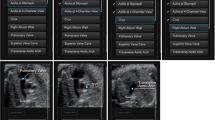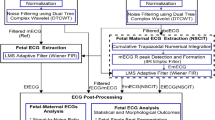Abstract
Congenital heart defect leads to the structural abnormality in neonatal. Congenital heart defect (CHD) is the major cause for 20% perinatal mortality and 50% infant mortality. However, the fetal cardiac screening plays a vital role to diagnose the CHD during second –trimester. Evaluation of fetal cardiac chamber structure is difficult due to small in size and movement. Four-chamber view has become the first and foremost view of echocardiography to detect structural malformations in the fetal heart. Furthermore, trained obstetricians, Pediatric cardiologists, maternal-fetal medicine specialists, and radiologists need proper knowledge and skills to identify the chamber structure from echocardiography. In addition, the effective diagnosis of fetal heart four-chamber view consumes more time and needs extremely skilled radiologists owing to their low quality, small signal to noise ratio and rapid movement of fetal heart ultrasound images. Thus, the diagnosis of CHD is the most challenging task. In this paper, we propose the Transverse Dyadic Wavelet Transform (TDyWT) algorithm to preserve the border and curvature of four chambers from 18 to 22 weeks ultrasound fetal heart image. We validate the proposed TDyWT algorithm with normal and abnormal images from Mediscan radiological centre. The performance of the TDyWT algorithm analyses qualitatively and quantitatively to prove border and curvature of the chambers is superior to other conventional methods.






Similar content being viewed by others
References
Allan G et al (2017) Simultaneous analysis of 2D echo views for left atrial segmentation and disease detection. IEEE Trans Med Imaging 36(1):40–50
Balaji GN, Subashini TS, Chidambaram N (2015) Detection of heart muscle damage from automated analysis of echocardiogram video. IETE J Res 61(3):236–243
Cao Y et al (2014) Segmentation of anatomical structures in four-chamber view echocardiogram images. 22nd International Conference on Pattern Recognition, IEEE https://doi.org/10.1109/ICPR.2014.108
Carneiro G et al (2011) The segmentation of the left ventricle of the heart from ultrasound data using deep learning architectures and derivative-based search methods. IEEE Trans Image Process. https://doi.org/10.1109/TIP.2011.2169273
Deng Y, Wang Y, Shen Y, Chen P (2012) Active cardiac model and its application on structure detection from early fetal ultrasound sequences. Comput Med Imaging Graph 36:239–247
Dietenbeck T et al (2012) Detection of the whole myocardium in 2D-echocardiography for multiple orientations using a geometrically constrained level-set. Med Image Anal 16:386–340
Dindoyal I, Lambrou T, Deng J, Todd-Pokropek A (2007) Level set snake algorithms on the fetal heart. In: Proc: 4th IEEE International Symposium on Biomedical Imaging, pp 864–867, April 2007
Dindoyal et al (2011) 2D-3D fetal cardiac dataset segmentation using deformable model. Med Phys 38(7):4338–4349
Guo Y, Wang Y, Nie S, Yu J, Chen P (2014) Automatic segmentation of a fetal echocardiogram using modified active appearance models and sparse representation. IEEE Trans Biomed Eng 61(4):1121–1133
Huang X, Lin BA, Compas CB, Sinusas AJ, Staib LH, Duncan JS (2012) Segmentation of left ventricles from echocardiographic sequences via sparse appearance representation. In: Proc. IEEE Math. Methods Biomed. Image Analy, pp 305–312, Jun. 2012
Huang X et al (2014) Contour tracking in echocardiographic sequences via sparse representation and dictionary learning. Med Image Anal 18:253–271
Leung KYE, Bosch JG (2010) Automated border detection in three-dimensional echocardiography: principles and promises. Eur J Echocardiogr 11:97–108
Lorena et al (2016) Left ventricle segmentation in fetal echocardiography using a multi-texture active appearance model based on the steered Hermite transform. Comput Methods Prog Biomed 137:231–245
Nirmala S, Sridevi S (2016) Markov random field segmentation based sonographic identification of prenatal ventricular septal defect. 7th International Conference on Communication, Computing and Virtualization, Procedia Computer Science vol. 79, pp 344–350
Pedrosa J et al (2016) Left Ventricular myocardial segmentation in 3D ultrasound recordings: effect of different endo and epicardial coupling strategies. IEEE Trans Ultrason Ferroelectr Freq Control 14(8):525–536
Sampath S, Sivaraj N (2014) Fuzzy connectedness based segmentation of fetal heart from clinical ultrasound images. In: Advanced Computing, Networking and Informatics, vol. 1. Springer, Cham, pp 329–337
Sardsud C et al (2015) Patch-based fetal heart chamber segmentation in ultrasound sequences using possibilistic clustering. Seventh International Conference on Computational Intelligence, Modelling and Simulation, IEEE Computer Society
Sridevi S, Nirmala S (2015) ANFIS based decision support system for prenatal detection of Truncus Arteriosus congenital heart defect. Appl Soft Comput J. https://doi.org/10.1016/j.asoc.2015.09.002
Tutschek B, Sahn DJ (2008) Semi-automatic segmentation of fetal cardiac cavities: progress towards an automated fetal echocardiogram. Ultrasound Obstet Gynecol 32:176–180
YEO L et al (2011) Four-chamber view and ‘swing technique’ (FAST) echo: a novel and simple algorithm to visualize standard fetal echocardiographic planes. Ultrasound Obstet Gynecol 37:423–431
Yu L et al (2016) Segmentation of fetal left ventricle in echocardiographic sequences based on dynamic convolutional neural networks. IEEE Trans Biomed Eng. https://doi.org/10.1109/TBME.2016.2628401
Acknowledgements
The Authors would like to thank the Mediscan systems, Centre for ultrasound, fetal care and genetics, Chennai for providing data and valuable suggestions to carry out this work.
Author information
Authors and Affiliations
Corresponding author
Rights and permissions
About this article
Cite this article
Nageswari, C.S., Prabha, K.H. Preserving the border and curvature of fetal heart chambers through TDyWT perspective geometry wrap segmentation. Multimed Tools Appl 77, 10235–10250 (2018). https://doi.org/10.1007/s11042-017-5428-9
Received:
Revised:
Accepted:
Published:
Issue Date:
DOI: https://doi.org/10.1007/s11042-017-5428-9




